Nonprofit Back on My Feet demonstrates the true power of the run

Terms and Conditions
Brooks will donate to Back on My Feet one pair of running shoes for each pair of shoes purchased and one item of running apparel for each item of apparel purchased on Brooksrunning.com between 0:00 EST 12/8/22 and 11:59 PM EST 12/14/22, up to 1,590 pairs of shoes and 3,345 apparel items. Valid on orders shipped to the United States only. Excludes purchases from AL, HI, MS, and SC. While supplies last. Past purchases do not apply. See Terms of Use for additional terms and details, including any eligibility restrictions.
Three days a week, a group of runners meets for regular runs in the Alphabet City neighbourhood of New York. But this is not your typical run club — some runners are experiencing homelessness, some are battling addiction, and some are volunteers who are there to help others get back on their feet.
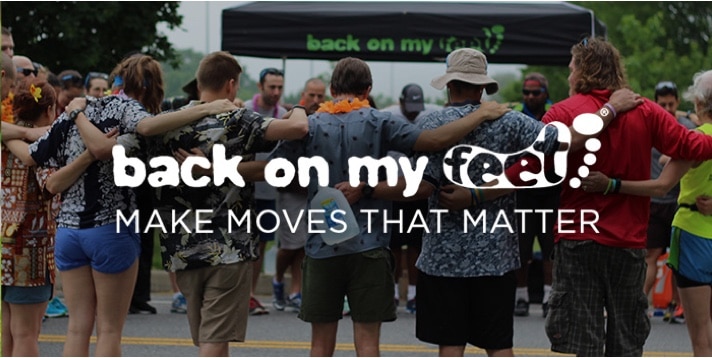
These runs — or the circle up as it’s called — are the catalyst for Back on My Feet, a national nonprofit that uses fitness as motivation to provide community support and a path to employment and housing for people experiencing homelessness.
According to Derek Drescher, a Back on My Feet alumnus who now works for the nonprofit, the circle ups range from one to five miles, and the group sees anywhere from 10 to 25 members in attendance. The numbers vary by location, but the goal is the same — to kick-start real change in lives through the run.
“My first mile, the first time out with the team, it took me probably 13 to 14 minutes to finish a mile. I wanted to stop at every block. But the volunteer who ran with me, Sarah, was so positive. I got through it, and at the end there were so many people cheering me on at the finish. I found out that they were all volunteers and people like me, and I couldn’t believe there was something so good out there,” Derek said.
Within a year and a half, Derek finished his first marathon in just under four hours and ran his first ultra two weeks later. He also moved out of a shelter and into an apartment and got a job.
I thought that I was meant to live this terrible life, but the program helped me see past that. If I could get up at 5:30 in the morning three times a week to be a part of this community, I saw how I could be a productive member of society too. I cannot imagine where I would be without Back on My Feet."
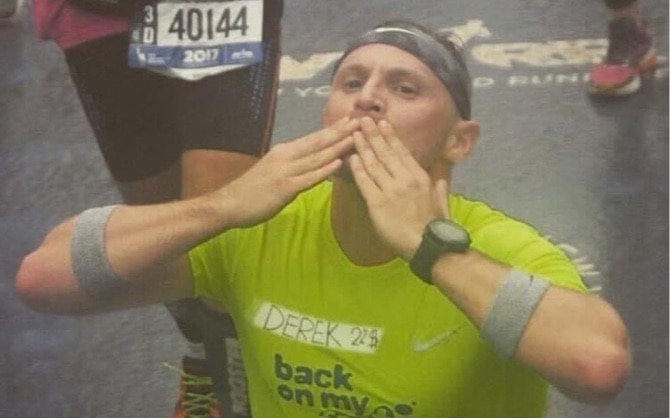
BoMF alumnus Derek Drescher finishes a race.
The program
Back on My Feet engages members at homeless shelters or addiction and treatment facilities around the country. Members commit to run or walk, typically in the early mornings and set running and fitness goals. After 30 days, they earn the opportunity to move into Next Steps — a pillar of the organization’s programming that focuses on workforce re-entry — where they develop a personal roadmap to independence.
During Next Steps, members attend financial literacy classes and job skills training provided by corporate partners. They can earn financial aid to remove barriers to employment and housing, such as work supplies, transportation, and security deposits. Members who achieve employment and housing become alumni members.
Joy Wilcox, Back on My Feet’s territory director for the West Coast, oversaw the organization’s recent launch in Seattle. She explained that volunteers are integral to the success of the organization’s programming.
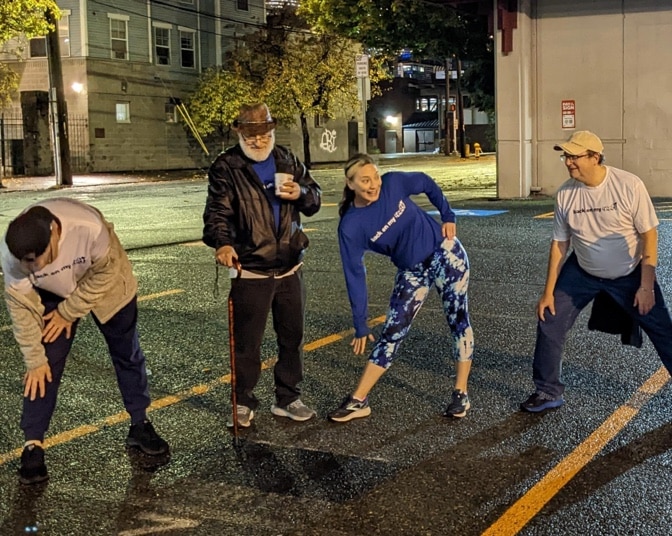
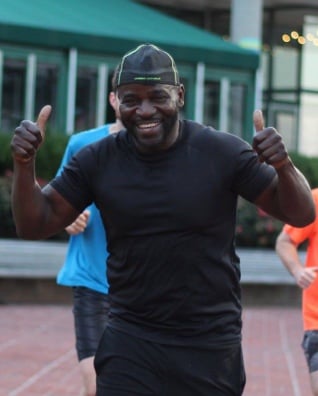
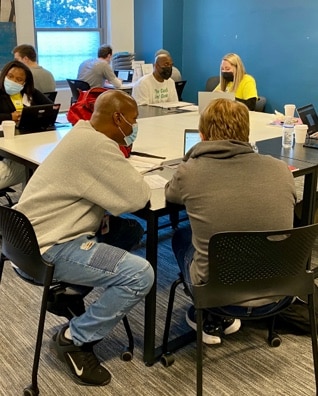
From left: A BoMF member enjoys a run; Joy Wilcox, BoMF West Coast Territory Director, stretches with members at a Seattle circle up; a group of BoMF members and volunteers work through job skills training.
“We want to build a support system around every single member. For that, we need volunteers to help with our circle ups. They should be social, enthusiastic, and eager to build community. These folks will run, walk, and talk with our members and be a positive force in those mornings. We also need Next Step mentors — that means career coaches and people who are interested in helping with career development. We look for people to help with resume writing, building LinkedIn profiles, and to assist with job seeking. Our volunteers work one to one with our members to achieve their employment and housing goals,” she said.
Day to day, Wilcox builds relationships with homeless shelters and addiction facilities in Los Angeles County, San Francisco, and Seattle. To reach more members, Back on My Feet needs strong and viable partnerships with facilities.
“Back on My Feet has an audacious goal to meet demand in our cities. There is plenty of data that drives us to expand into new areas where we can address and combat homelessness. It’s important to remember that human beings are behind those data points."
We want to wave a magic wand to fix things, but we have to work within some very complicated systems for both members and volunteers."
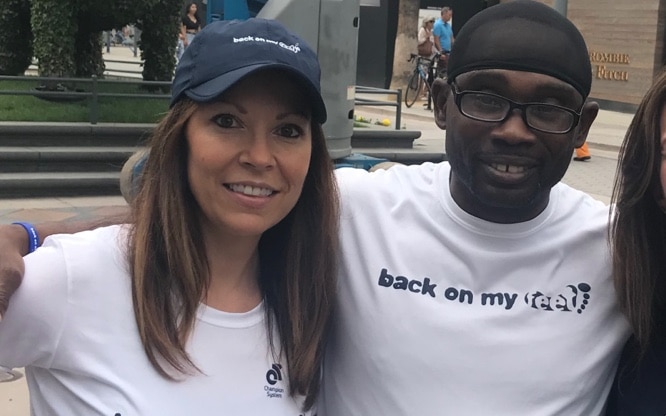
BoMF CEO Katy Sherratt and a member pose at an event.
CEO Katy Sherratt brings years of corporate experience to Back on My Feet and has worked to help navigate the nonprofit through those systems into operational sustainability and large-scale growth. Her path at Back on My Feet started in 2012 with volunteering. She was working for Accenture at the time (they were a donor) and decided to help out with a circle up. Katy was dealing with some injuries and was paired up with a woman named Sandra, who had been struggling a bit with participation in the program.
“Everyone ran off and left us, and in the space of four city blocks, I learned more about homelessness than I ever understood. As we got more comfortable with each other and approached the last block, I said ‘We are going to try this. Let’s run one block.’ We started to run, and then you hear everyone at the finish line. No one leaves — everyone waits until the end. They were cheering her name. ‘Sandra! Sandra! Sandra!’ I saw it in her face. That was the moment it clicked for her.
We hugged it out and she turned to me and said, ‘No one has ever believed in me like you all just believed in me.’"
Sandra ran her first 5k shortly after that circle up. She went back to school part time to study social work and found full-time employment with the help of the program. Katy still gets emotional when she shares Sandra’s story. That day changed Sandra’s life, but it also dramatically shifted Katy’s — she decided to use her knowledge and experience to help strengthen Back on My Feet as an organization.
“I think when I came in, we weren’t sustainable. It was an incredible idea, but you have to run it like a business. You need things like KPIs. But we’re working towards changing people’s lives. Not making widgets, not selling things. We had to restructure, and that was painful. We had to make sure we were in a place financially and structurally to rapidly grow,” she said.
Runners know the feeling of accomplishment that comes with completing a run. But what if you live in a homeless shelter? Where do you get that sense of accomplishment?
“When you go out, and you’re able to run a city block for the first time, then the next week a half mile, then two, then five, you really develop a sense of self-worth. It changes your whole perspective,” Katy said.
“Now you start thinking you can ace that interview. You can get that job, you can move into your own place. Running is a tool, a building block, that allows our members to gain confidence. They wake up excited for that run, and they go to sleep feeling accomplished.”

By the numbers
Back on My Feet has helped almost 10,000 members find jobs and homes since they launched. The organization has welcomed 2,000 new members to its program during 2022 and more than 70% of members successfully make it through the program. Here is how Back on My Feet is making a difference in 17 cities across the US:
- 83% of members maintain employment
- 200,000+ volunteers and supporters
- 10,000+ jobs and homes achieved
- 1,200,653 miles run by members
- 500+ members have run marathons
- 1,800+ members have run more than 100 miles
Here are ways you can give back:
-

Volunteer with Back on My Feet
-

Run with us. Run for Us.
-

Address barriers in running communities
